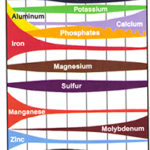The pH of soil and water is a measure of the amount of acid or alkaline they contain. It ranges from 0 to 14, with 7 being neutral. A pH below 7 is acidic and above 7 is alkaline.
Nutrient deficiencies can occur if the pH is outside of the range that a particular plant likes – tomato plants are happiest with a pH around 6.8, just on the acid side.
Garden Soil
If you grow tomatoes on an allotment or directly in your garden soil, measuring the pH could be very useful and will give you the opportunity to make adjustments for the following season. To change the pH value of soil may take some time for organic additives such as egg shells to break down in the soil.
Lime raises pH and ammonium sulphate lowers soil pH.
Grow Bags
If you use grow bags and multi-purpose compost to grow your tomatoes, it may be better to adjust the pH of the water you use than the soil. You will probably only use that soil for tomatoes for one season, unless you have a method of avoiding disease when re-used.
Rain Water
Saving rain water is ideal as the pH is usually slightly acidic and ideal for tomato plants and many other plants too!
Here’s a graph that shows the accessibility of nutrients to plants at various pH levels.

You can see that iron, manganese and zinc are available at low levels when the pH is slightly acidic. This isn’t a problem because tomato plants only need very small amounts of these nutrients.
However the macro nutrients of nitrogen, potassium and phosphorus are highly available – a good thing!
Calcium, magnesium and sulphur are also required at good levels, but notice how little calcium is available when the pH is below 7.0.
Tap Water
Hard water usually has a high pH and contains a lot of calcium. Soft water usually has a low pH and is low in calcium. If you live in a hard water area, you will know by shaking your kettle – if there are bits in it that rattle, you have hard water.
This means that if we live in a soft water area, or mainly use rain water from a water butt, we may need to give calcium as a supplement to our plants.
However, it’s better to give water to tomato plants that is slightly acid (below a pH of 7.0) because they will be able to absorb a wider range and larger amount of nutrients – calcium can be added as a foliar feed.
Tap water also contains chlorine so it is best to fill up the watering can the evening before you use the water – the chlorine will reduce or dissipate when left overnight.


Anonymous
Helo sir, i planted my tomatoes and the yield was good ‘big fruits’ i just made sure i removed every weed which came up, so what was available in my soil for such a yield.
Hilary
Hi Nick,
The Ph of the soil in my tomato container is 8.0. Can you advise me what needs to be added?
Thank you.
Nick
Hi Hilary, if the pH of your container soil is a bit high (8.0) I wouldn’t be too concerned.
If you live in an area with high pH tap water, I would add a squirt of lemon juice to the watering can, which is a mild acid, next time I water.
This will help to reduce the pH slightly but if the plants look OK, all should be fine.
Charlie Lum
Is a ph o 2.5 too acidic for newly planted tomatoes?
Nick
Yes, pH 2.5 is too low try to reach around 6.8 in soil, 6.4 for hydroponic growing.
gabby chicote
hi sir nick, may i know if tomatoes can grow in ph level 9.5 . what are the factors included?
Nick
They would grow but be affected by nutrient deficiencies – the nutrients that cannot be absorbed at so high a pH.
alan pyper
hi nick my tomatoes are not doing much. i was wondering if i fed them nettle tea twice a week if it might help or should try watering them twice a day?
Nick
Hi Alan,
I always find that my tomatoes do better with less water rather than more. I would try the nettle tea.
Regards,
Nick
Rhys Jaggar
Nick, when you make up your calcium foliar feed, do you use tap water for that? I made my first lot up with rain water but your chart says to me that that might not be very effective.
Nick
Hi Rhys,
Rain water or tap water that has stood for a day would be better to use in a foliar feed, but it doesn’t matter too much on the leaves – it’s the root zone that causes the complications.
Regards,
Nick
jess allaway
Hi Nick,
That’s interesting. I occasionally put three or four left over plants under big sheets of glass leaning against the wall at the back door. They are watered from the outside tap and never ever do as well as the greenhouse plants which are watered from a butt filled from a burn which runs through our garden. I never gave it a thought before that the water could be making the difference. Although our tap and burn water is soft, the tap water as you say contains fluoride. Thanks for that information.